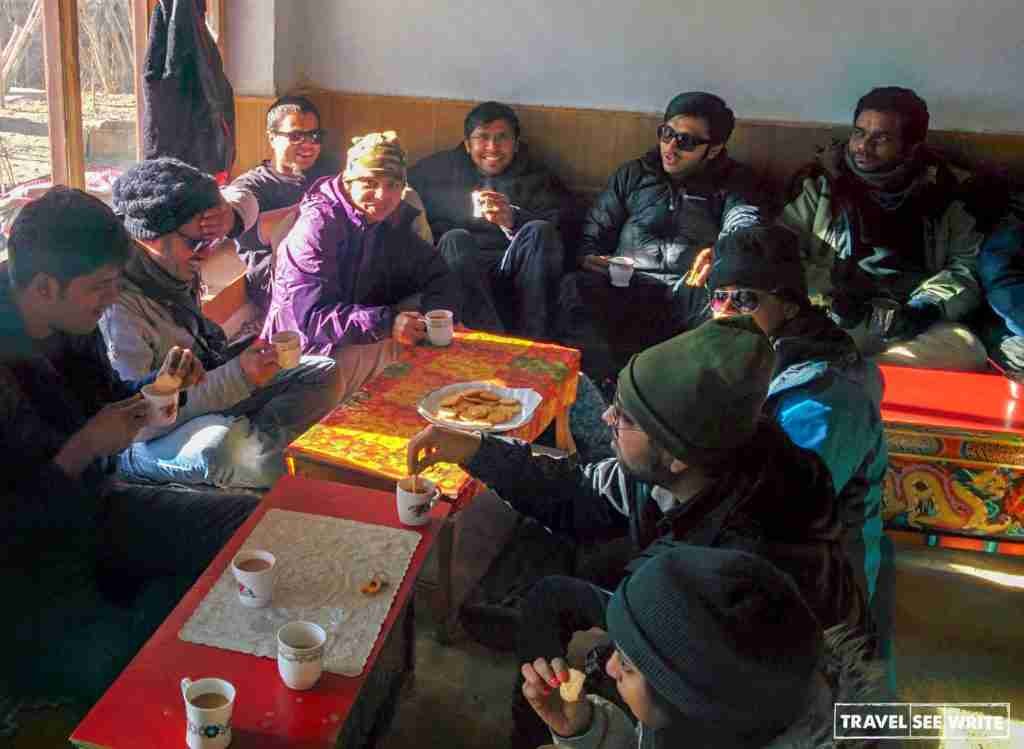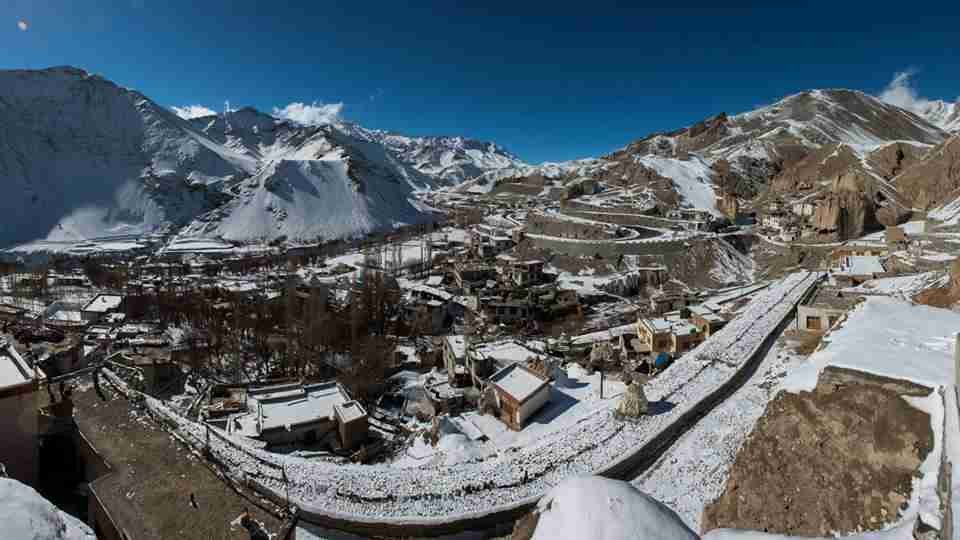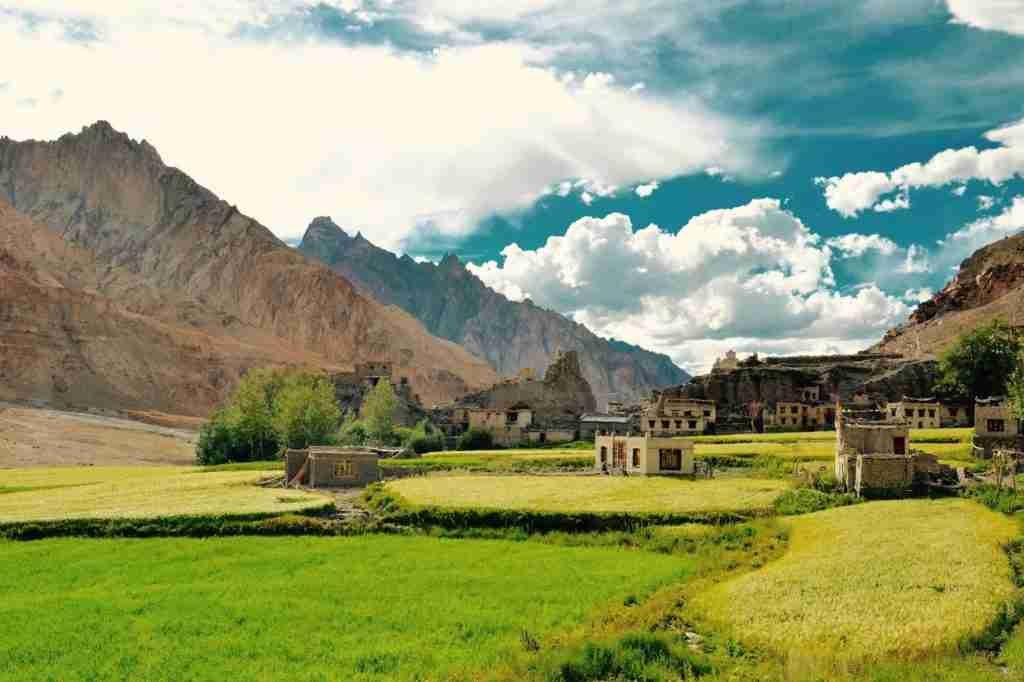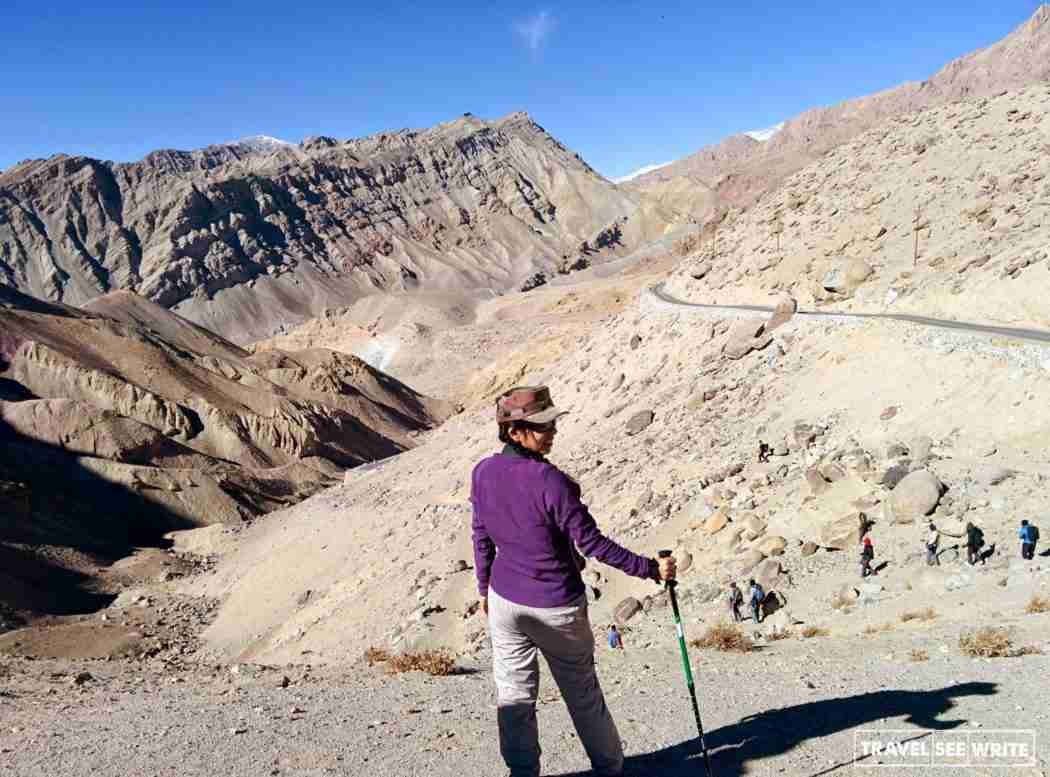
Why Adventure in Ladakh so special
Ladakh is one of my favourite places to visit, not just in India but in the entire world. It is the place that changed my destiny – from being a corporate slave to becoming a full-time traveller. During my several trips to the land of high passes, I have explored all facets of the region – from popular to offbeat, Buddhist cultural immersions to partaking in adventure activities, from being a part of group travel to solo trekking in the unchartered territories, witnessing peaceful nights at Pangong Tso to living with the Changpas on my tumultuous journey to Demchok and Chumur. Unfortunately, some of these places along with Galwan Valley, and Hot Springs have lately become the bone of contention in the bloody India-China face-offs. However, when I visited the region was largely peaceful and I am sure it will soon return to happy days.

My love for Leh Ladakh is so much that I made sure to visit it in every season. I call it the land of modern pilgrimage where I have walked from hill to hill, crossed river to river, ate with locals in towns and villages, covering all corners of the mountainous region- from Turtuk to Demchok, verdant valleys to serpentine gorges, mega glaciers to tiny villages, high altitude lakes to seasonal streams and everything in between. I experienced the soulful beauty of Ladakh in all kinds of transport – cars, bikes, local buses, army trucks, hitch-hiking and on foot.

I understand most of the tourists who visit Ladakh, don’t have the luxury of time and resources like I had. Therefore, they like to see the main highlights of Ladakh in a week and thus choose to travel in cars or bikes. In 7-10 days, you can visit Leh town, the Indus valley, the Nubra valley, Pangong Lake and Tso Moriri Lake. While the Indus valley is famous for centuries-old ancient monasteries, both the lakes are on every travellers’ dream trip to Ladakh.

While a road trip isn’t a bad idea, my personal favourite is trekking in Ladakh as it connects you to the soul of Ladakh and brings you up close to the unimaginable beauty spots that you might miss when in a vehicle. It is a great option to connect with nature and also go to places that are not easily accessible and hence have limited visitors.

However, trekking in the coldest desert of the world is not like trekking in lowlands. You should be in good physical shape to do trekking in Ladakh. Most importantly, to avoid Acute Mountain Sickness, it is a must to get well acclimatised before you embark on your trek. Treks in Ladakh vary from tough to moderate – you can choose basis your stamina and time in hand.
While there are dozens of famous treks available, the Sham valley trek and the Markha valley trek are among the best treks in Ladakh, recommended for someone looking to gain a first-hand trekking experience in the region.
The Sham Valley trek
- Difficulty level: Easy to moderate
- Highest elevation: 3,874 metres
- Distance: 32 km
- Duration: 4 days and 3 nights that can be reduced to 3D2N or extended to 5D4N

Popularly known as the baby trek because of its easy nature, the Sham Valley trek is best suited for beginners or families. But if you are not in your best physical condition, then this multi-day trek could seem daunting for many. I did this trek in February 2015 when the whole landscape was blanketed in multi-layers of snow, and the temperatures were always sub-zero, sometimes touching as low as -15 degrees. To make matters worse, once we even got stuck in a blizzard-like snow-storm. But come summer, and this Narnia-like landscape transforms into a lush apricot valley where the smiles of the locals will fill your heart with exceptional warmth.
Day 1: Likir to Yangthang
After acclimatising for two days in Leh, I drove for one and a half from Leh to reach Likir, which is the starting point of the trek. If you have no timing issue, you can spend a night here, or you can straight proceed towards Yangthang village after visiting the Likir monastery.

Set picturesquely on a little hill in the Likir village of the Sham Valley, near the Indus River it was constructed in 1065 by Lama Duwang Chosje, under the command of the fifth king of Ladakh, Lhachen Gyalpo. For a city dweller like me, Likir village appeared to be relatively isolated, but it was once on a major trade route. En route from the Likir village to Yangthang, I crossed two easy passes – Phobe La and Chagatse La. The climb from Likir to Phobe La was gentle, and in an hour, I was on the top of the pass. From here, I had two options – hike down on the rough, muddy track and join the road below (which was a short cut) or take the long loops of the tarmac road. I chose the first one.
After walking for a while on the flat tarmac road, I took a little break at Sumdo, an idyllic tea-break point from where you have to cross the stream. Refreshed from the hot tea and cold stream water, I along with my guide kept hiking on the main road for an hour until we reached the second and the last pass of the day – Chagatse La. From Chagatse La, we scrambled down for another 30 mins to reach our destination of the day – the village of Yangthang (11,909 ft) that fell on our left side. While the camping site near the mainstream enticed me, I chose to spend the night in the cosy Ladakhi homestay. The entire journey on foot with modest speed and a few pitstops from Likir to Yangthang took around 4-5 hours.

Tip: If you have time and energy, I highly recommend visiting the Ridzong Monastery that is an hour away from Yangthang. I loved the quiet environs of this pristine and secluded gompa.
Day 2: Yangthang to Hemis Shukpachen
After a hectic first day where I crossed two passes, the second day seemed like a breeze with only one pass to cross – Tsermangchan La, which is the highest pass on this trek with an altitude of 3,874m. With stomach full and backpack tucked on my shoulder, I headed back from the Yangthang Village onto the road that brought us to the village a day before. Heading Northwards, we descended for a bit, crossed a stream before climbing up west again to Tsermangchen La (12,303 ft). The panoramic view from the pass was too good to miss, and despite the cold, I decided to take a break on the top before heading down to my next night halt – Hemis Shukpachen, often referred as the mythical Shangri-La. It has the right balance of adventure, exotic feel, and traditional Ladakhi charm.

My guide told me that this is one of prettiest villages in Ladakh and I couldn’t agree more. While the entire landscape was snow-covered in February, in summers, the village looks like a fairytale village from a storybook. Plenty of gurgling streams surrounded by shady willows and large barley fields make the village stand like an oasis in otherwise desolate, rocky mountains. It is the best place to see the Ladakhi system of water distribution. Glacial meltwater is distributed to the fields via a network of channels.

Tip: Book your stay with the Himalayan Homestays or camp out near one of the brooks. If you can spare some time, do visit the Lamayuru monastery from here via Ang village.
Day 3: Hemis Shukpachen to Temisgam
On the third day, we walked for an hour before hiking up to a small pass called the Mebtak La. Once we reached the pass, we started descending to reach Ang village near the river. We crossed the river and walked for a while before entering Temisgam village. Thankfully our cosy homestay was close to the road, which gave us ample time to bond with the locals.
Tip: Don’t forget to visit the Temisgam Palace, monastery and Nunnery. If short on time, catch a vehicle from Temisgam to return to Leh.
Day 4: Temisgam to Khalse

Next day we started a little late since we didn’t have to walk for long. Gingerly we started walking towards Tia along the road for sometimes before crossing the river. A few minutes walk later; we started climbing the Bongbong La to reach the Leh-Kashmir highway. We met a lot of locals on the way who were going to Leh too. We had a choice to grab a taxi instead of walking, but we chose to walk for a while. Our stroll continued up to Khalse from where we drove back to Leh.

Tip: Book your taxi beforehand in Leh as none are available in Khalse. From Temisgam you can also visit Lamayuru or Dha-Hanu villages (Brokpa Aryan villages).
The Markha Valley trek
- Difficulty level: Moderate to Difficult
- Highest elevation: 5,260 metres
- Distance: 78 km
- Duration: 6 days

The Markha Valley trek is easily the most popular trek in Ladakh. Since Markha is situated in the Hemis National Park which offers fantastic landscapes and the chance to see wild animals, it is a trekkers’ delight. The Markha valley trek is more difficult than the Sham Valley trek as one has to cross the Kongmaru La pass (5,260m) on the fifth day. It usually takes six days to complete the trek, but there are options to extend the trek for those who have more time.
Day 1: Chilling – Skyu
You have to reach Chilling, which is the starting point of the trek and 60 km far from Leh. After crossing the Zanskar River, you will enter the Markha valley. It takes only 3 hours to reach Skyu village. It is the most relaxed day of the trek.

Day 2: Skyu – Markha
Today, you will walk almost 21 km to reach Markha village. However, the trail is full of scenic landscapes and barren mountains. You can also visit the old fort and monastery at Markha village.

Day 3: Markha – Hankar
You will need to hike for around five hours to reach Hankar, which is a small village at an altitude of 4,050m. Tall mountains surround the village, and you can also get a glimpse of the mighty Kang Yatse peak (6,400m) from a distance.

Day 4: Hankar – Nimaling
It is perhaps the hardest day of the trek. You have to hike uphill to reach Nimaling camp. It takes around 5-6 hours to cover a distance of 10km. You will spend the night in a tent at Nimaling which is located at an altitude of 4,850m. Take a good rest to prepare for the next day.
Day 5: Nimaling – Shang Sumdo via Kongmaru La pass
Today, you will cross the Kongmaru La pass, which is the highest point on this trek at an altitude of 5,260 metres. There is a spectacular view of Kang Yatse peak from the top. After that, it is a long walk downhill to reach Shang Sumdo.

Day 6: Shang Sumdo – Hemis
It takes around 4 hours to reach Hemis from Shang Sumdo. However, the walk is easy. Hemis monastery is the largest monastery in Ladakh. You can spend some time exploring the place before driving back to Leh.

As you know, there are many good reasons why tourists enjoy travelling in Ladakh. If you like to challenge yourself and to be in the wild, trekking is one more reason to add Ladakh to your bucket list!
What to pack for trekking in Ladakh
- Day Backpack with bare essentials
- Trekking Bag (60-70 Liters)
- Waterproof best Quality Hiking Shoes
- Gaiters for hiking in winter
- 2 lightweight waterproof trekking pants.
- 3 light weight trekking T-Shirt
- down jacket to protect from the cold, windcheater to protect from the wind and Poncho to protect from the rain
- 4 pairs Trekking socks, gloves, slippers/sandal
- Thermals – top and bottom
- 2 Trekking Poles
- UV Protected Sun Glasses.
- 1 quick-drying towel.
- Refillable Water Bottle.
- Moisturiser, lip balm, sunblocks (SPF 50 and above) and wet wipes.
- Headlamp/Torch with spare batteries.
- Basic first aid kit
- Dry fruits and chocolates
Travel Tips for trekking in Ladakh
- The best time for trekking in Ladakh is from May to early October. The Sham valley trek being at a lower altitude can be done throughout the year.
- Both Sham valley trek and the Markha valley trek have good homestays in villages, which allows you to experience local life.
- You will need to hire a taxi to get to the starting point of the trek, and a pickup vehicle at the end of the trek. Book a taxi in advance on the Leh-Ladakh Taxi Booking’s website to avoid the last-minute hassle. The best part is taxi rates are fixed in Ladakh.
- For the Sham valley trek, a taxi from Leh to Likir costs Rs. 2,100 and a taxi from Temisgam to Leh costs Rs. 4,700.
- For the Markha valley trek, a taxi from Leh to Chilling costs Rs. 4,000 and a taxi from Hemis to Leh costs Rs. 2,400.
- When trekking in Ladakh, it’s highly recommended to be accompanied by a professional Ladakhi guide. A local guide ensures that you are safe in the mountain, and he will also share plenty of interesting information about Ladakh and its culture. You will also need a horseback rider with horses/mules to carry your bags. Indeed, even if you think that your backpack is not so heavy, carrying it on a multi-trek at high altitude can quickly become a nightmare for your legs and your shoulders.
- There are hundreds of agencies in Leh which can arrange transport, accommodation, guide and horseman for you. Ju-Leh Adventure is one of the well-known trekking agencies in Leh, rated number one on TripAdvisor
- The cost of trekking in Ladakh depends on many parameters. One of the main parameters is the number of people in your group. To give you a rough idea, the 6-day Markha valley trek would cost around Rs.25,000 per person for a group of 5 persons.
Further Reading
- UNDERSTANDING THE CULTURE OF LADAKH THROUGH UNTOLD HUMAN STORIES
- LEH LADAKH ONE WEEK TRIP
- LUXURY STAY IN LEH, LADAKH (INDIA): THE GRAND DRAGON LADAKH
- OFFBEAT LEH LADAKH ROAD TRIP TO THE THIRD POLE OF THE WORLD
- QUIET FLOWS THE INDUS
- DELHI TO LEH LADAKH: EXTREME AND UNPLANNED ADVENTURE
- EXTREME ROAD TRIPPING IN CHANGTHANG, LADAKH – PART II
- EXTREME ROAD TRIPPING IN CHANGTHANG, LADAKH – PART III
- FALLING IN LOVE SECOND TIME WITH MY FIRST LOVE, PANGONG
- 10 REASONS WHY YOU SHOULD VISIT LADAKH IN WINTERS
- LADAKH TRIP – RESTORING MY SANITY
- ROMANCING LADAKH IN WINTERS
- CHADAR TREK (LEH TO LINGSHED) (TRAVELOGUE)
- 11 SOULFUL REASONS TO TRAVEL TO LADAKH
- 11 DAYS IN LEH LADAKH – 11 FACES OF BEAUTY – Part 1
- 11 DAYS IN LEH LADAKH – 11 FACES OF BEAUTY – Part 2 & 3
- 11 DAYS IN LEH LADAKH. 11 FACES OF BEAUTY – Part 4
- 11 DAYS IN LEH LADAKH. 11 FACES OF BEAUTY – Part 5 & 6
- 11 DAYS IN LADAKH. 11 FACES OF BEAUTY – 7 & 8
Have you ever done trekking in Ladakh? How was your experience, or what would you like to explore next time? Please share your feedback in the comments section below.






The landscapes of Ladakh are pure magic and unlike anything else. There is so much to experience in Ladakh. The call of adventure from the mountains, the call for mysticism from the monasteries, and much more. Trekking is a great way to immerse oneself in the beauty of Ladakh, loved reading about the Sham Valley and Markha Valley treks, both are so amazing and the vistas breathtaking.
What beautiful views. I can see why you would trek through this region. I’m sure the views are much better than in a car, on a roadway would be. Great tips on what to bring as well.
Trekking is by far the best way to explore an area. It’s much easier to get out into the off-the-beaten path places. Unfortunately, I’m a “little” out of shape these days to do too much trekking lol.
Sounds fantastic, albeit, I’d opt for cycling – where possible. You are as close to nature as hiking, however, you’re faster (wrong philosophy, I know…) Also, after Peru, I know what mountain sickness feels like.
Albeit I think that I’ll never do this, it was an inspiring read and I appreciate how thorough this guide is. You don’t get that too often in this jungle of blogs so I really need to point that out.
How beautiful! Your photos are stunning, I can only imagine how amazing it was to see Ladakh in person! Trekking is such a great way to explore.
What a heavenly place! I’d love to explore Ladakh as trekking through beautiful valleys and seeing impressive mountains is right up my street. Your post has loads of helpful routes and tips, thanks!
This is such an incredible take, in all seasons. In fact, Ladakh must be one of the most beautiful and breathtaking places in the world! I can only imagine what it feels like to survey these scenes in person. While I am not so ambitious to trek it in winter as you have, I think the winter scenes may be the best. So crisp! Thank you for sharing your incredible journey(s), photos, and useful tips for novice and experienced trekkers alike. I enjoyed reading this!
Ladakh has definitely been on my bucket list for a while but this post just gave me an extra amount of motivation. I’ve never really trekked before but now I really want to give it a try!
I am in love with all these beautiful photographs. Thanks for sharing this article 🙂
What delightful perspectives. I can perceive any reason why you would trek through this locale. I’m certain the perspectives are far superior to in a vehicle, on a street would be. Incredible tips on what to bring also.
I suspect more restrictions will come up in the region due to tension with China. Hopefully not.
Archana Ma’am You click very well photographs… Now I’ve been started following you on Instagram 🙂
have you ever visited Nainital.?
In 2010 I was there. We went to Kardhung-La. Amazing views
The Sham Valley Trek is so exciting and beautiful. Have so far been reading about it. Seeing the snow-covered trail of Temisgam to Khalse looks interesting for the first time. Markha Valley trek is something new, I haven’t heard of it before. I hope I can do both the treks during my visit to Ladakh.
I love Ladakh in all the seasons and the best way to explore the place is through hiking. Both Markha and Sham Valley treks are great to see the beauty of Ladakh.
Agreed! I have also been also watching Ronnie and Barty’s and India in Motion’s videos on Ladakh. Such offbeat, beautiful and pristine destinations and cultures.